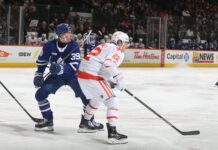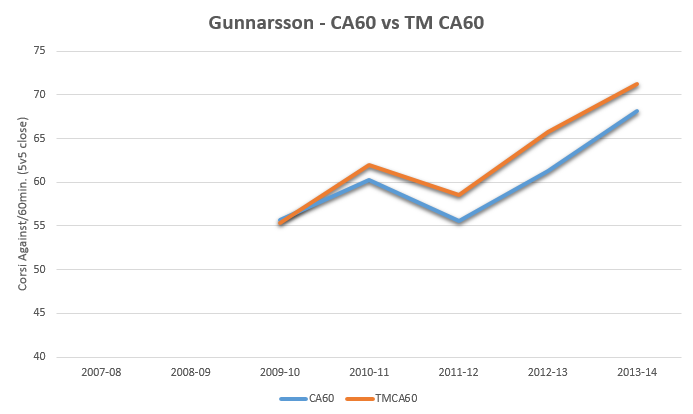This past off season, Maple Leafs management brought in two veteran defensemen to replace some combination of Paul Ranger, Carl Gunnarsson and John-Michael Liles/Tim Gleason, with the goal of giving the defense a new look and hopefully reducing the number of shots the Leafs give up.
This shouldn’t be a difficult task, as last season the Leafs were easily the worst team in the NHL in shot attempt against rate. The question is: Are Robidas and Polak up for the task? Let’s have a look.
In a recent post of mine at HockeyAnalysis.com, I looked at what I called CA60RelTM, which in long form can be read as Corsi Against per 60 Minutes of ice time Relative to Team Mates. In English, what this essentially tells us is how much better or worse a player’s teammates are performing when they are playing with a player compared to when playing apart from him. This, generally speaking, is a pretty good indicator of the kind of impact a player has on his team; it tells us whether he makes the players he plays with better, worse, or if he has no significant impact.
CA60RelTM is calculated by taking the player’s CA60 and subtracting his teammates’ CA60 when they are not playing with him (the TMCA60 stat found at stats.hockeyanalysis.com). Alternatively, we can look at these two individual statistics in chart form. Here is a chart of Robidas’ CA60 and TMCA60 during 5v5 play over the past 7 seasons:
The blue line is Robidas’ CA60 and the orange line measures how Robidas’ teammates fared when not playing with Robidas. For CA60, it is better to have a lower number and for the blue line to be below the orange line, which generally speaking is true for Robidas. Robidas has generally had a positive effect on his teammates shot attempt against rate, which is good, although it has been closer to a neutral effect in the past couple of seasons.
Here is the same chart but for Roman Polak:
Unlike Robidas’ chart, this chart for Polak does not look too promising. Except for the 2000-10 season, Polak’s teammates have given up more shot attempts against with Polak on the ice than without him. That, obviously, isn’t good.
Now, how about the guy the Leafs traded away in return for Polak, Carl Gunnarsson?
Exactly the opposite of Polak, Gunnarsson has consistently reduced the number of shot attempts against when he is on the ice. Defensively, in terms of shots attempts against, this does not look like a positive trade off for the Leafs.
We can also look at this another way by looking at how Leaf defensemen of the past and present have performed in terms if CA60RelTM. The table below looks at their 5v5 close CA60RelTM over the past 4 seasons. With the greater sample size of 4 seasons of play, I decided to look at 5v5 close stats to eliminate the majority of any score effects that may occur.
| Defenseman | CA60 | TMCA60 | CA60RelTM |
|---|---|---|---|
| Franson | 57.9 | 60.9 | -2.9 |
| Gardiner | 60.8 | 62.8 | -1.9 |
| Robidas | 55.4 | 57.1 | -1.7 |
| Liles | 58.8 | 60 | -1.2 |
| Gunnarsson | 62.8 | 62.9 | -0.1 |
| Polak | 52.7 | 50.9 | 1.8 |
| Phaneuf | 66.5 | 60.9 | 5.6 |
| Gleason | 65.3 | 59.7 | 5.7 |
Robidas looks okay here, but Polak appears to be a bit of a drag on his teammates, which is what we saw in the above charts. It also looks like Franson and Gardiner should be getting more ice time and the coaching staff should be less concerned about their defensive play.
Rielly is not listed in the table as he has only played one season. As an FYI, his CA60RelTM in 5v5close situations last season was 4.8, which is indicates he still has some learning to do when it comes to shot prevention. That said, I think if we looked at the numbers in more detail we would probably see that Rielly was much worse in the first half of the season than he was in the second half. I look forward to seeing what he does in this upcoming season and monitoring if he can take a step forward in his defensive game.
To summarize, I think it is a difficult argument to make that the defensemen changes alone will have a significant positive impact on reducing shot against totals; in particular, the Polak for Gunnarsson move seems to be a net negative. Perhaps more hope resides in the 5v5 defensive zone coverage adjustments underway in training camp.


































![Craig Berube Post Game, Leafs 6 vs. Sabres 3: “Our team played really hard in front of [Murray]… They were dialed in for him” Craig Berube, Toronto Maple Leafs head coach](https://mapleleafshotstove.com/wp-content/uploads/2024/12/berube-leafs-tor-pg-100x70.jpg)

